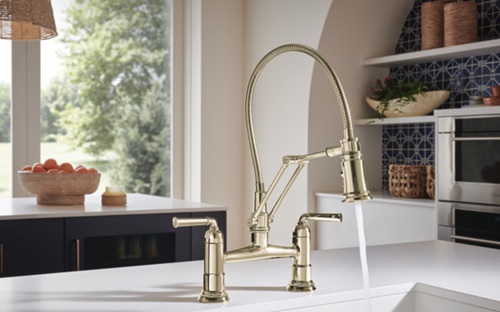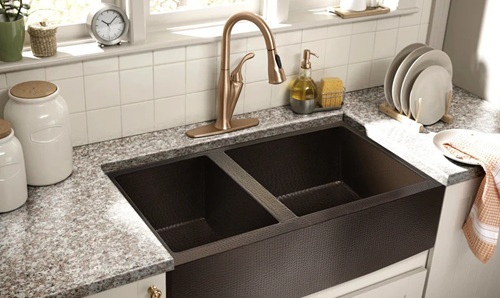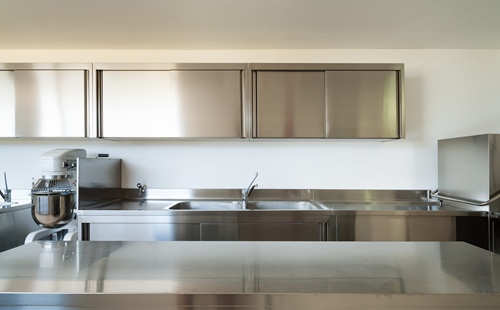Bridge faucets are a stylish nod to traditional plumbing design, with a timeless charm that appeals to homeowners looking to blend function with aesthetics. These elegant fixtures are characterized by their two-handle design (typically for hot and cold water) connected by a horizontal “bridge” above the sink deck or countertop, with a single spout rising from the center.
But while bridge faucets certainly have visual appeal, are they right for your kitchen? Let’s walk through a complete and unbiased evaluation of the pros and cons of bridge faucets—so you can decide if this vintage-inspired design matches your modern needs.

What Is a Bridge Faucet?
A bridge faucet is a type of kitchen or bathroom faucet where the hot and cold water lines connect above the counter or sink deck in a visible “bridge” structure. Water mixes within this bridge and is delivered through a single central spout. This design is often associated with vintage, farmhouse, and traditional kitchens, but many manufacturers now offer modern versions as well.
Bridge faucets are available in both deck-mounted and wall-mounted configurations, with or without sprayers.
Pros of Bridge Faucets
1. Timeless and Elegant Design
Bridge faucets are favored for their classic, architectural beauty. They add a distinctive focal point in farmhouse, traditional, or transitional kitchens and pair beautifully with apron-front sinks, marble counters, and vintage hardware.
Design Tip: Choose finishes like polished brass, brushed nickel, or oil-rubbed bronze for a more authentic vintage look.
2. Visible Craftsmanship
Unlike most modern faucets where connections are hidden, bridge faucets proudly show off their construction, creating a mechanical elegance. The exposed joints, smooth arcs, and crisp angles make them look handcrafted and high-end.
3. Separate Controls for Hot and Cold Water
Bridge faucets typically have dual-handle designs, which give you precise control over water temperature. This can be advantageous when working with delicate tasks like baking or brewing where water temperature matters.
4. Durable, All-Metal Construction
Because many bridge faucets are inspired by traditional craftsmanship, they often feature solid brass bodies and ceramic disc valves, which are built to last decades with proper maintenance.
Fact: High-quality bridge faucets have fewer plastic components compared to many mass-produced single-handle models.
5. Available in Wall-Mount Options
Wall-mounted bridge faucets free up valuable countertop space and make cleaning easier around the sink. This can be especially useful in utility sinks, prep sinks, or minimalist kitchen designs.
6. Easy to Clean Around Deck Area
Unlike modern single-hole faucets with bulky bases, most bridge faucets are spaced out with minimal contact at the deck, which makes cleaning around the faucet area easier. This can help reduce build-up from water spots and grime.
Cons of Bridge Faucets
1. Higher Cost
Bridge faucets are generally more expensive than standard single-handle or pull-down faucets. Because they’re considered a specialty or designer item, you’ll find that prices often start around ₹12,000–₹30,000 ($150–$400) and can go much higher.
Tip: Premium finishes like unlacquered brass or custom metalwork can push costs into luxury territory.
2. Complex Installation
Bridge faucets typically require two or more holes in the sink or countertop, and proper alignment is essential. If you’re retrofitting one into a kitchen that previously had a single-hole faucet, modifications may be necessary, adding labor and plumbing costs.
Warning: Wall-mounted versions are even more complex to install and may require rerouting plumbing lines.
3. Less Convenient Than Pull-Down Faucets
Many bridge faucets lack integrated sprayers or pull-down heads, making them less practical for filling large pots, rinsing dishes, or cleaning the sink. While some models come with a side sprayer, they may not be as powerful or easy to maneuver as modern pull-down wands.
4. Takes Time to Adjust Water Temperature
With two separate handles, adjusting the temperature takes longer than with a single-handle faucet. This can be inconvenient during busy cooking sessions or when you’re washing hands quickly between tasks.
5. Requires More Maintenance to Avoid Drips
Because bridge faucets have more joints and moving parts, they may be slightly more prone to leaks at the connections over time. However, this is mitigated in high-quality models with ceramic disc cartridges.
Maintenance Tip: Regularly check the seals and joints, and clean mineral build-up to extend the faucet’s life.
Bridge Faucet vs. Other Faucet Types
| Feature | Bridge Faucet | Single-Handle Faucet | Pull-Down Faucet |
| Design Aesthetic | ✅ Classic/Vintage | ✅ Modern/Minimalist | ✅ Modern/Functional |
| Water Temperature Control | ⚠️ Manual (2 handles) | ✅ Easy with one hand | ✅ Easy with one hand |
| Sprayer Functionality | ⚠️ Often separate/no sprayer | ✅ Integrated pull-down | ✅ Integrated pull-down |
| Installation Complexity | ⚠️ High | ✅ Simple | ✅ Moderate |
| Maintenance Needs | ⚠️ Moderate | ✅ Low | ⚠️ Moderate |
| Countertop Compatibility | ⚠️ Requires 2+ holes | ✅ Works with most sinks | ✅ Common |
| Price Range | ❌ Higher | ✅ Lower to moderate | ✅ Moderate to high |
| Best Suited For | Traditional/Farmhouse Kitchens | Modern and Compact Kitchens | Busy, Functional Kitchens |
Tips for Choosing the Right Bridge Faucet
- Verify Hole Spacing – Most deck-mounted bridge faucets require 8-inch center-to-center spacing. Make sure your sink or countertop accommodates this.
- Pick the Right Finish – For authenticity, choose unlacquered brass (which patinas over time) or brushed nickel for a timeless look.
- Check for Sprayer Add-ons – If a side sprayer or filtered water tap is important to you, select a model that offers these options.
- Go with Trusted Brands – Reputable manufacturers like Kohler, Rohl, Perrin & Rowe, Kingston Brass, and Signature Hardware are known for build quality and customer support.
- Plan for Maintenance – Keep white vinegar handy for cleaning mineral deposits, especially if you live in a hard-water area.
Should You Choose a Bridge Faucet?
✅ Ideal for You If:
- You love classic design and craftsmanship
- You’re building or remodeling a farmhouse, vintage, or transitional kitchen
- You’re okay with slightly more maintenance for a standout piece
- You want a decorative faucet that enhances your kitchen’s personality
❌ Not Ideal If:
- You need a high-functioning sprayer or pull-down wand
- You’re on a tight budget
- Your sink or countertop isn’t configured for multi-hole installation
- You prefer modern, minimalist features and fast use
Final Verdict
A bridge faucet is more than just a plumbing fixture—it’s a statement piece that adds timeless elegance to your kitchen. While it may not offer the convenience of modern pull-down faucets, it brings a unique aesthetic and sense of craftsmanship that few other faucet styles can match.
If you’re remodeling a kitchen with a vintage or transitional flair and are willing to invest in quality and maintenance, a bridge faucet can become the perfect blend of style and function in your home.

